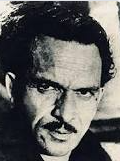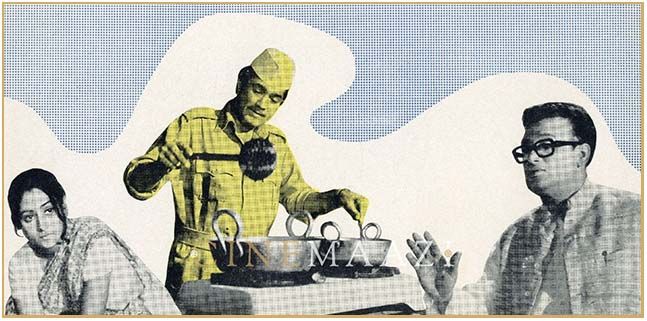Tastes Like a Revolution- Exploring Food Inequality in Film
Subscribe to read full article
This section is for paid subscribers only. Our subscription is only $37/- for one full year.
You get unlimited access to all paid section and features on the website with this subscription.
Not ready for a full subscription?
You can access this article for $2, and have it saved to your account for one year.
Rising above popular market demands, are films that have used the motif of food to deliver sharp comment on social, economic and even personal inequality.
Bhara ho pet toh sansar jagmagata hai
Sataye bhook toh imaan dagmagata hai…
(On a full stomach, the world sparkles
But plagued by hunger, one’s faith wavers)
These simple lines from the Nutan-starrer Seema (1955) powerfully capture the critical importance of food, emphasising the fine line it draws between hope and delinquency, life and death, morality and immorality, in the life of its central character, an orphan girl. A marked contrast to food metaphors in more recent mainstream cinema songs that luridly compare the female body to a ‘tandoori murgi’ or a ‘mirchi’… That said, commercial Hindi cinema of a certain vintage has been lovingly fed on homely sustenance prepared by doting mothers and housewives, often including the ubiquitous gajar ka halwa to celebrate the success of a son who has passed his exams/ secured a job, or kheer to mark an auspicious occasion. Food has invariably been at the centre of happy families and festive celebration portrayed onscreen, whether the mandatory bhang ke pakode and lassi to mark Shiv Ratri, or even comedic cake fights as seen in films like Chhote Nawab (1961) and Jaane Bhi Do Yaaro (1983). Food might not occupy a prominent position per se, but is comforting and joyful in its very presence, as seen in films like Bawarchi (1972) and Hum Saath-Saath Hain (1999).
In relative minority, are films across Indian languages which use the medium of food to make a searing comment on social, economic and even personal inequality. Insightful cinematic journeys into the subtleties and ramifications of food, they incorporate themes of liberation, caste discrimination, desire, power and more, providing much-needed food for thought.
Plight of the have-nots
The tragic shortage of food has been portrayed to tremendous effect to define economic inequality in a newly independent India in films such as Do Bigha Zamin (1953) and Roti (1974). The former, Bimal Roy’s hard-hitting drama, presents the stark reality of a poor farmer who faces a gamut of challenges including an unjust society, as well as natural disasters like drought and famine, as he struggles to seek a better life for his family. It centres around the concerns of food security—connected to the well-being of the agricultural sector—as well as joblessness and the crisis of urban life. Seventy years later, it remains a grim reminder of the continuing callousness of the country towards farmers.
Likewise, Mehboob Khan’s Roti focuses primarily on the social problem of hunger against the 1940s backdrop of industrial activity, which saw the country moving rapidly towards capitalism and modernisation. The emergence of a new capitalist class is juxtaposed against the problem of hunger born out of the Depression of the late 1930s and early 1940s, reaching its nadir in the Bengal famine. A real critique of Indian society and the evils of capitalism, the film opens with a shot of a farmer tilling the fields, and wheat swaying in the breeze, “underlining a sacred harmony between the peasants and the land, and defining ruralism as both spiritual and productive,” (Omar Ahmed, Reclaiming Mehboob’s Roti). The next sequence establishes the city as a dehumanising place. Leftover food from a grand banquet is tossed onto the street, from where it is gathered by the starving and homeless. The commentator, “as an imaginary metonym of discord looks down at the slums saying devilishly: ‘Why do you cry “bread, bread”! Are you hungry? Are you hungry?’. The next shot cuts to an old, gaunt man hobbling through the wretched slums. We hear a hushed response from an oppressed, silent majority replying, ‘We are hungry!”
In a nod to socialist beliefs traceable to the rise of a left wing movement in India, influenced by a new Soviet regime, the commentator berates the homeless sleeping on the footpath, telling them to instead occupy the mansion nearby in which a man lives by himself. “Ek aadmi ko itne bade makaan mein rehne ka koi haq nahin hain,” he says, “Kal se uss makaan mein jaakar sona. Kal se main tumko yahaan na dekhun. Kissiko apna haq tak maloom nahin hain!” he pointedly muses. Inspired by German Expressionism, Roti deals with two models – that of a millionaire, possessed by money and power in an industrial civilisation, juxtaposed against that of a tribal couple living amidst nature in a liberated community according to the ideals of co-owned resources.
Satyajit Ray’s “moving”, “elegiac”, “superb and achingly simple” Ashani Sanket (1973), based on the novel of the same name by Bibhutibhushan Bandopadhyay, is set against the backdrop of the 'manmade' famine that wiped out 5 million people in 1943. At the centre of this “gentle, humanist” film is Gangacharan, an educated Brahmin, who has recently arrived to settle in the village with his wife Ananga. With the “simplicity of a fable,” it goes on to humanise the gigantic catastrophe. As a critic pointed out, “Numbers as huge as [5 million] can be dangerous. A tragedy of such magnitude becomes an event abstracted by arithmetic. But Ray's artistry alters the scale. His concentrating on just a few victims of the famine causes such massive loss to become real, immediate. Ray makes numbers count.” The film also makes a subtle yet pointed comment on caste: when an untouchable-caste woman dies of hunger—the first starvation-related death in the village—Gangacharan breaks the taboo by picking up her hand take her pulse. He also feels obliged to give her a proper cremation.
Contemporary food portrayals
As poverty and hunger gradually grew unpopular as themes in mainstream cinema, ironically, decades later, in Zoya Akhtar’s Dil Dhadakne Do (2015), we see binge eating as a coping mechanism to suppress and soothe negative emotions. Heartbroken by her insensitive husband’s behaviour and treatment towards her, not to mention his rampant flirting and cheating, the well-heeled Neelu (Shefali Shah) breaks down in the privacy of her cruise cabin and cries her heart out. And then she stuffs her face with chocolate cake. As she desperately seeks refuge in food in private, her stress eating suggests she swallows her true feelings as well, before she dries her eyes and gets back to pretending all is well with her world.
Director Rajkumar Hirani gleefully turned the concept of ‘ma ke haath ka khaana’ on its head in 3 Idiots (2009). Readers will recall the scene wherein Raju (Sharman Joshi)’s mother, preparing dinner while she complains about the soaring prices of vegetables, heeds a cry from her paralysed husband, and casually reaches over to use the rolling pin with which she has been rolling rotis, to scratch the man’s chest, before resuming her chore. Suffice it to say, Raju’s nauseated friends wouldn’t be doing much eating that night!
Striking against patriarchy
In a more serious vein, Ritesh Batra’s quiet, melancholy The Lunchbox (2013) serves up the tales of two individuals that serendipitously blend when a lunchbox delivery goes inadvertently wrong. Thought they do not physically meet, a correspondence is struck up when Ila (Nimrat Kaur)’s home-cooking, which is meant for her husband, ends up on Saajan Fernandes (Irrfan Khan)’s desk. Stuck in a loveless marriage, in which she is neither seen nor heard, Ila goes on to find purpose in meticulously preparing a host of delectable dishes - not for her uncaring spouse but for the appreciative elderly widower on the eve of retirement from his 35-year job at an insurance company. Through the lunchbox, which also carries a daily exchange of notes to each other, Ila and Saajan escape their lonely worlds to form a connection that circumvents societal strictures and promises a hopeful future.
If The Lunchbox gently conveys the blossoming of Ila, the Malayalam film The Great Indian Kitchen (2021), is a full-frontal attack on the patriarchy. Shorn of any semblance of love, cooking emerges as a symbol of oppression, giving rise to frustration and anger in this Jeo Baby directorial. We are invited into the domestic life of a newly-wed woman, which begins on a sweet note but quickly spirals into unpleasantness. The daily drudgery of endless meal preparation and the many unpleasant realities of the primitive kitchen, including filthy utensils and leaking taps, take a heavy toll. Worse, her egotistical husband is rudely inconsiderate of her needs and feelings. Revolting against the endless monotony of cooking and cleaning up after the men, she eventually finds her weapon of retaliation in the kitchen itself – a pail-full of murky, grimy, dirty kitchen sink water, which she drenches the men in, in a scene of stunning retribution. Breaking free from the shackles, she finds new life as a dance teacher, and is shown arriving in her own car. The film ends on a chilling note, as a similar fate awaits her ‘new replacement’.
The Great Indian Kitchen served its purpose of putting on screen the long hours a woman spends in the kitchen. As the director shared, “I realised that many among my male friends are completely oblivious of what the women around them did all day in the kitchen. Their role in the business of cooked food ended with pronouncing it good or bad at the end of a meal, after everything from the dishes to the glass of water was laid out before them.”
The Neeraj Ghaywan directed short Juice (2017) also highlights the “everyday casteism that is rampant in Indian homes,” as Shirin Mehrotra writes in the essay ‘The social life of food in Indian cinema’. Exploring the theme of gender inequality, it stars Shefali Shah as Manju Singh, a woman who is hosting a get-together of families along with her husband Brijesh (Manish Chaudhari) during a particularly hot evening. The script was drawn from Ghaywan’s memories of watching the dynamics between men and women in his own house as a child. “I have grown up seeing in my family circles the men being sexist and misogynistic while the women would be squeezed into the kitchen. The living room has been an area of male entitlement. Women automatically take the route of the kitchen. And children see this, internalising it. I also found that popular culture looks down on housewives.” Hailed for taking “an unyielding and cold look at the way patriarchy operates in our homes,” the character’s graph goes from meekly accepting her role to getting increasingly frustrated. As the heat in the kitchen soars with the endless preparation of food and snacks, so does her own realisation of the multiple impositions of gender roles around her. Her final act of rebellion is simply to drag a chair to sit in front of the cooler in the living room, where the men are, and to sip her juice in comfort. The guests are shocked into silence. She has claimed her independence from gender.
Challenging vegetarianism & ‘purity’
Food in film has also been generously used to propagate clichés such as meat-eating being the practice of the evil-doers; ironic, in a country that is predominantly non-vegetarian. Whether Gabbar Singh (Amjad Khan) lolling in front of meats grilling on a spit in his den (Sholay, 1975), Khilji (Ranveer Singh) brutishly tearing into chunks of meat (Padmaavat, 2018), or then Nana Patekar gorging on an entire chicken (Kamaal Dhamaal Malamaal, 2012) in a fit of gluttony, the villains are invariably portrayed as carnivores. Writing on ‘Why films should not sell vegetarian fanaticism’, Vikram Doctor conveys his irritation at the scene in Jodhaa Akbar (2008) featuring the Rajput queen serving her Moghul emperor husband a Rajasthani meal she prepares that eschews all the meat dishes that Rajputs themselves savoured and comprises only the vegetarian fare of Marwari merchants. Even Hrishikesh Mukherjee’s Bawarchi (1972) gently suggests that vegetarian equivalents of meat are preferable, when Rajesh Khanna as Raghu (Bawarchi), the gifted chef, transforms yam and green bananas into kebabs that the mutton-and-egg-eating men happily tuck into, thinking it to be meat. The identification of vegetarianism as morally superior is a troubling labelling.
Cocking a snook at popular mainstream narratives, Malayalam director Lijo Jose Pellisery employs meat as the main character in his films Angamaly Diaries (2017) and Jallikattu (2019), using the consumption of pork and beef respectively—meats that are considered taboo for upper-caste Hindus and are also part of Kerala’s food culture—to subvert concepts of vegetarianism and ‘purity’. Similarly, if Axone (2019) highlights the prejudice around the dish that blends fermented soybean paste and pork, Kaaka Muttai (2015) depicts the shame of an impoverished mother whose sons eat eggs stolen from the nests of crows, for strength.
Within its market-dictated limitations, popular cinema has occasionally tried pushing the envelope. Tarla (2023) explores food writer and chef Tarla Dalal's journey and legacy as an iconoclast during the early liberalisation period, empowering women through the art of cooking. Ki and Ka (2016) is notice-worthy for its portrayal of a working wife and a househusband, who is depicted willingly handling all the household chores including cooking. In another welcome role reversal, Cheeni Kum (2007) portrays its male lead (Amitabh Bachchan) whipping up delicacies to prove his worth to a prospective father-in-law, while English Vinglish (2012) is not just about learning a new language, but a housewife who makes scrumptious ladoos, and is trying her hand at entrepreneurship. The Malayalam language film Ustad Hotel (2012) touched upon the traditional resistance towards the idea of a boy choosing to study culinary arts and become a chef, and it took Amole Gupte’s Stanley Ka Dabba (2011) to gently bring to the fore issues of marginalised children and child labour through the simple yet poignant tale of the motherless Stanley and his lunchbox.
As Gupte puts it, “Every tiffin has a story.”








.jpg)


